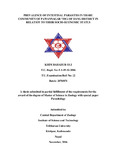Please use this identifier to cite or link to this item:
https://elibrary.tucl.edu.np/handle/123456789/1449| Title: | Prevalence of Intestinal Parasites in Tharu Community of Pawannagar Vdcs of Dang District in Relation to their Socio-Economic Status |
| Authors: | Oli, Khim Bahadur |
| Keywords: | Intestines;Parasites;Socio-economic status;Community |
| Issue Date: | 2016 |
| Publisher: | Central Department of Zoology Institute of Science and Technology Tribhuvan University Kirtipur, Kathmandu |
| Abstract: | Intestinal parasitosis is becoming a common problem among people of least developing countries living under low socio-economic profile. This study was carried out to determine the prevalence of intestinal parasites in Tharu people of Pawannagar VDCs of Dang district in relation to their socio-economic status. The study was carried out with prepared questionnaire method to determine the knowledge, attitudes and practices between March to November, 2016. Altogether 200 stool samples were randomly collected from different age groups and sexes and were preserved in 2.5% potassium dichromate solution. These stool samples were examined by direct smear method in the Parasitology Laboratory of Central Department of Zoology, Kirtipur, Kathmandu. Out of 200 peoples, 59 (29.5%) were found to be infected with one or more intestinal parasites among them the prevalence rate of parasitic infection in males were 34 (31.19%), whereas females were 25 (27.47%) (χ²=0.18017). Finding of the study showed that, highest prevalence rate was in the age group above 41 years was 33.33%, where lowest was 28.67% (χ²=0.10876) in the age group 20-40 years. Altogether, five species of intestinal parasites were detected. Entamoeba histolytica was most predominant among protozoa whereas Ascaris lumbricoides was detected among helminth parasites. The distribution of helminthic infection 51 (86.44%) were higher than the protozoan infection 8 (13.55%). The prevalence of A. lumbricoides 27 (45.76%) was the highest whereas Enteriobius vermicularis 2 (3.38%) was the lowest parasites. But the study showed that single 52(88.13%), double 5 (8.47%) and multiple 2 (3.38%) parasitic infections in the Tharu communities. Tharu people were interviewed on the basis of parasitic infection, knowledge of the transmission, control and prevention of the parasites. Most 141 (70.5%) people were unaware and 59 (29.5%) people were aware about the intestinal parasitic worms. Female were more 31 (34.06%) aware than male 28 (25.68%). Thus, the wide parasitic infection among Tharu people are attributed to poor hygienic condition, contaminated water, unhygienic food, poor sanitary disposal condition and low socio-economic status of these communities help to increase the high prevalence rate. |
| URI: | http://elibrary.tucl.edu.np/handle/123456789/1449 |
| Appears in Collections: | Zoology |
Items in DSpace are protected by copyright, with all rights reserved, unless otherwise indicated.

